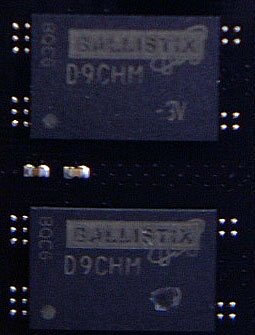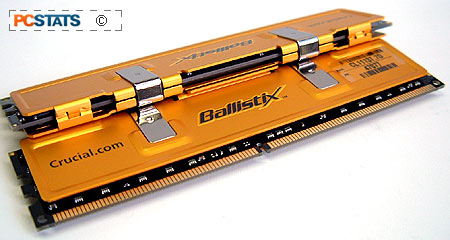 One of the perks of manufacturing your
own DRAM is that it can labeled with anything you want, without having to sand
anything down first. In the case of Crucial's Ballistix, the FPGAs are labeled
as Ballistix memory. Everything else is pretty non descript, we see the markings
"D9CHM" and "-3V."
One of the perks of manufacturing your
own DRAM is that it can labeled with anything you want, without having to sand
anything down first. In the case of Crucial's Ballistix, the FPGAs are labeled
as Ballistix memory. Everything else is pretty non descript, we see the markings
"D9CHM" and "-3V."
By default the DDR-2 Ballistix memory is
capable of running up to 333 MHz (or PC5300 speeds) while maintaining 4-4-4
memory timings at a voltage of 1.9V. It appears as though Crucial is not to wary
of consumers raising the voltage a bit to reach those higher speeds either. The
memory timings are on the conservative side but then again so are most PC5300
DIMM's on the market.
While we did warn you earlier about
removing the heatspreader off the DIMM, I want to really emphasize that FBGA
DRAM modules are very delicate! PCstats learned this the hard
way when we ended up killing one of the sticks in the process of removing the
heatspreader so that we could provide you with a clear shot of the DRAM. While
there was no visible damage to the memory module, it never worked again after
this picture was taken. I suspect a broken solder ball connection is the
reason.
As AMD has not jumped on the DDR2
bandwagon just yet, and are not anticipated to do so until the middle of 2005 at
the earliest, that makes Intel the only game in town when it comes to DDR2
RAM.
At the time of these tests, the
i925X-based test motherboard we are using is affected by Intel's FSB lock. This
means there we'll have to come back and retest Crucial's DDR-2 Ballistix memory
for overclocking again in the future. In the mean time, let's see how these
DDR-2 modules performed!

A Little Overclocking to
Start
After dropping in the yellow Ballistix
DDR2 RAM into a Gigabyte GA-8ANXP-D motherboard, we set about changing the
memory multiplier to 2.66x, and tightened the timings to 3-3-3. To not much
surprise, the Ballistix DDR2 had no problems running at these timings, at PC4200
speeds.
Next was the FSB overclocking adventure,
but that was uneventful all the way up to 216 MHz. Anything higher than that and
the system would refuse to POST. Raising voltages or loosening up on memory
timings didn't help things either. I'd expect the Ballistix to go a little
further, and when we get a more overclocking friendly i925x motherboard we will
be resting the Crucial Ballistix memory to see how high they can
reach.
